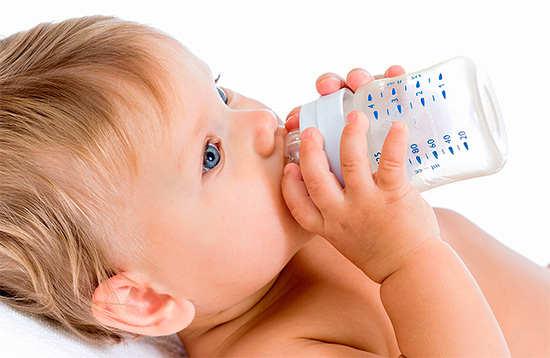
Bottle caries is a disease of young children, mostly from 2 to 3-4 years old. The quite original name of this disease is due to one of its causes: bottle caries in children develops milk or milk formulas from a bottle because of the habit of drinking before bedtime or at night, after which large amounts of food remains in the mouth all night, which are the main cariogenic factor.
The photo below shows a typical example of bottle caries:


By analogy, bottle caries are also called “nursery”, “kefir”, “milk”, there are even the names “pacifier caries” and “night feeding caries” - these terms also unequivocally indicate the main sources of the problem and the age of patients. In the medical reference books of all these terms there is none at all: according to the nature of the course and the primary causes, the disease is a typical caries, and the name “bottle caries” is everyday.
Causes of illness
The main reasons for the development of bottle caries are the same as for other types of carious lesions: damage and further destruction of dental tissues under the influence of acids produced by bacteria multiplying in the oral cavity. Food for these bacteria are mainly the remnants of carbohydrates, which are deposited on the teeth after feeding. But now the reasons for the presence of such food debris in the mouth and the inability of the body to suppress the activity of bacteria are secondary and have a different effect on the risk of developing bottle caries.
Photos of teeth with bottle caries before and after treatment:
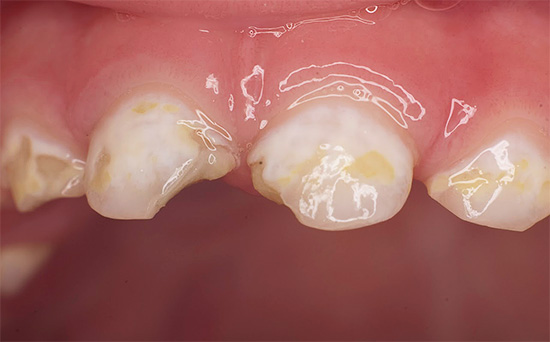
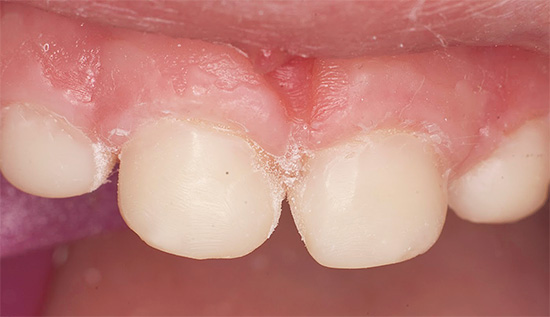
Most dentists consider nightly feeding the baby to be the main cause of bottle caries. And it does not matter if a child eats from a bottle, or sucks a breast - lactose (milk sugar) is contained in mixtures and in breast milk, it is also an ideal substrate for the development of bacteria.
But by itself, this cause does not always lead to the emergence of the disease: in many cases, children who are fed at night do not develop caries. And, on the contrary, in some small patients, signs of bottle caries appear even with a clear feeding schedule with the last meal before going to bed and brushing teeth after it.
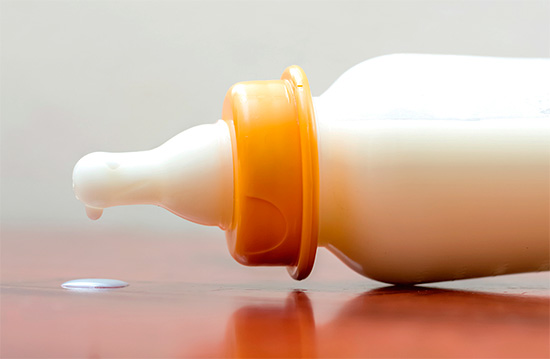
Therefore, other reasons play an important role in the occurrence of bottle caries:
- Weakening of immunity and insufficient bactericidal properties of the baby’s saliva: in the usual case, the child’s body’s own defenses should be sufficient to suppress the activity of bacteria in the mouth. In children who (or who) do not brush their teeth, eat at night and do not have caries, it is saliva that protects the teeth from destruction. The converse is also true: if the ability of saliva to resist bacteria is less pronounced, the teeth can be affected even with good oral hygiene. At the same time, other diseases of the body can affect the reduction of the bactericidal qualities of saliva, for example, diabetes, influenza, intestinal infection. In any case, the child can be weaned from night feedings and carry out proper tooth brushing. In such conditions, the development of caries will be significantly slowed down, and attentive parents will always have time to show the baby to the dentist when it is still possible to save and leave a tooth intact.
- Errors in the preparation of the baby's diet. Sweets, sweet cereals and juices, confectionery and flour products, the remnants of which linger on the teeth, most contribute to the reproduction and prosperity of microflora in the mouth.Impact on the condition of the teeth and the lack of coarse food: carrots, apples, which, when chewed, erase plaque. There may also be a shortage in the diet of foods high in calcium and phosphorus - fish, natural dairy products.
- The regional factor can also affect: with a lack of fluorine in drinking water, tooth enamel weakens and is damaged more quickly by aggressive acids.
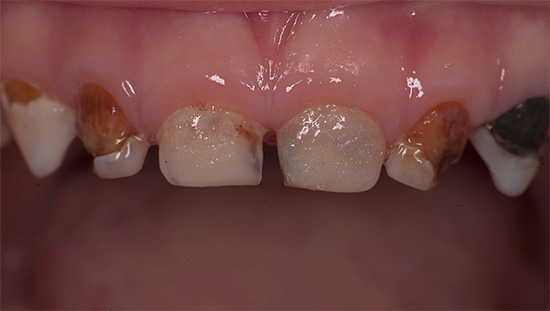
In general, proper oral hygiene is always important - a bottle of milk at bedtime will be less harmful to the teeth if the child brushes his teeth after feeding.
The cause of bottle caries is also considered to be heredity, but in most cases the parents justify their laziness and unwillingness to brush the teeth of the child or teach him to do it themselves with heredity. Remember: even with a genetic predisposition, proper oral hygiene and a healthy diet will significantly reduce the likelihood of caries development!
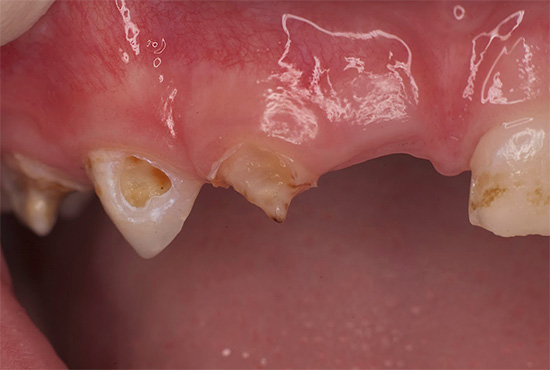
Feedback:
“Half a year ago we noticed just such a sore problem with our eldest (3.5 years). At first it seemed to me that he had damaged his teeth with something, because exactly under the gums on the front three, such dash became yellowish. As if hit about something and chipped.The dentist looked at this case and said that it was bottle caries. Indeed, we especially do not drill children, we tried to teach how to clean the teeth, but neither Andryusha, nor even Valik, regularly do this. Well, they are both calm. Andrew normally sat in the chair, the doctor put two simple fillings on him, and on one he treated it with some tool without a drill. Now we’ve been brushing our teeth for half an hour in the evening with both of them. ”
Anna, Saint Petersburg
The appearance of teeth with bottle caries
In the photo below - typical bottle caries at a late stage of development. In some places, the tooth enamel has completely collapsed, and deep lesions of the dentin are visible, which quickly darkens due to pigmentation with various food dyes and bacterial waste products:
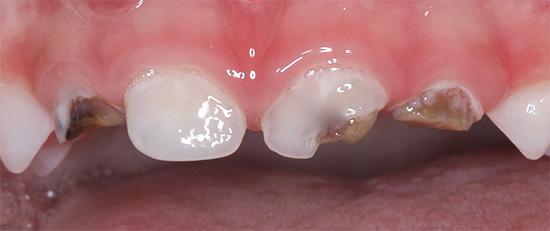
At the earliest stages, bottle caries may appear as bright matt spots (white or chalky spots), which eventually become rough on the enamel, gradually deepening and darken.
Next on the photo - the average caries, which covered several teeth at once. Such a simultaneous lesion is a characteristic diagnostic sign of bottle caries:
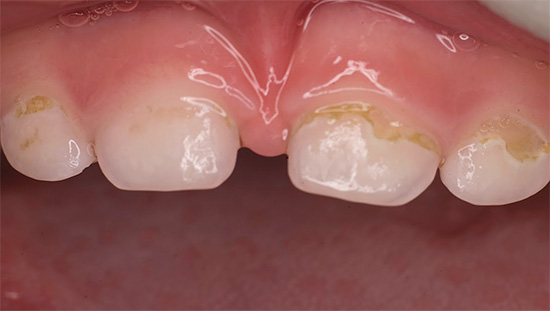
As a rule, bottle caries first affects the front four teeth of the child. A carious process often begins in the gum zone, quickly covers the entire tooth over the gumline along the perimeter and penetrates into the deep layers of enamel. The defeat of the gum zone of the tooth is a characteristic feature of bottle caries.
Generally speaking, deep bottle caries indicates an irresponsible attitude of parents to the health of the child.: it is easy to notice the pathology already in the early stages, and only parents who pay attention to the baby’s teeth only with constant complaints can bring a child to the clinic with teeth half-eaten by caries.

Important!
Bottle caries can develop not only on several front teeth, but also on one single tooth, and on molars. Therefore, the child should regularly and carefully inspect all the teeth, and not just the front.
Treatment of bottle caries: rules and features
The main rule that parents should remember: treat caries need always! Excuses, they say, do not need to treat bottle caries, because baby teeth will fall out anyway - this is a crime against a child.
Premature destruction of milk teeth often leads to irregularities in the arrangement of permanent teeth and defects in the development of the jaw, often spoils the child’s diction and leads to a lisp. Yes, and just rotten teeth over the years - this is the reason for constant ridicule at the child by their peers, which may be the reason for the formation of an inferiority complex.
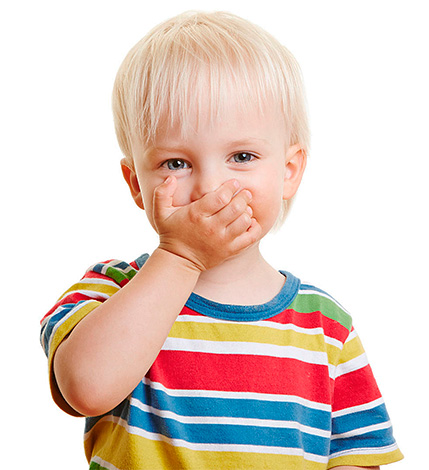
Pediatric dentist comment
Premature tooth decay is, first of all, an infectious process in the oral cavity. Infectious foci are localized in the rotting teeth themselves, with food lingering there, as well as on the roots of the milk teeth, leading to the risk of impairing the development of the primordia of the permanent teeth beneath them. Any infection in the mouth, all the more so serious, is the risk of developing maxillofacial diseases (up to "fluxes" and the appearance of serious inflammatory processes in the bone tissue) and a number of related diseases or their deterioration.
If caries is found, the child must be shown to a good dentist.
Successful treatment of bottle caries in children is possible at almost any stage of the development of the disease, but with deep damage to the tooth, it can be significantly complicated by the proximity of the pulp chamber to the damaged tissues.
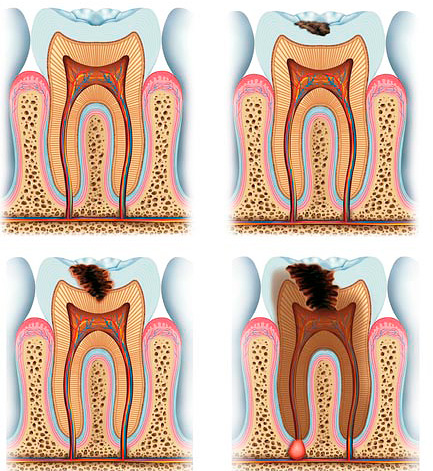
In principle, the treatment of bottle caries in children does not differ from the management of other types of the disease, but it is methodologically much more difficult because it is difficult to make the child sit in a chair with an open mouth for a long time. In many cases, professional procedures require anesthesia, which frightens many parents. That is why it is very important to notice the signs of caries at the earliest stages of its development, when it is possible to treat the disease without the use of a drill with special preparations as directed by the doctor, and at home.
Feedback
“We are 2 years and 8 months old. Caries began, the doctor said that the bottle - we still suck a pacifier at bedtime and eat yogurt at night. On the two teeth of the upper front, such abrasions appeared dark, as if they were painted with something. We came to the dentist, there is a special children's office, with drawings on the walls, toys, a doctor in a bright robe. And to no avail.Sasha immediately rushes into a cry, only her mouth is opened in the chair. I had to do anesthesia. It is very unpleasant, before that I had to pass several tests on purpose, in general, so restlessly, everything looks like a serious operation. But the doctor says that usually the child at the second or third visit is already getting used to and allows you to do everything without anesthesia. But in general, do not be afraid of him, it’s better than in six months his teeth will bend at all. ”
Tatyana, Odintsovo
At the stage of a white or weakly pigmented spot, it is often possible to almost completely restore the damaged enamel area with the methods of remineralizing therapy. At home, for this purpose, the teeth are regularly treated with special gels such as R.O.C.S. Medical Minerals or GC Tooth Mousse. But it is impossible to make a decision about treatment with their own help: it is only a doctor who should determine the stage of caries development and prescribe treatment.

Professional methods are more effective in the early stages of bottle caries development, when the doctor treats the porous damaged enamel surface with special infiltrants (ICON system). This procedure takes 1-1.5 hours of time, is quite laborious, requires the use of a rubber curtain (cofferdam) and is carried out under anesthesia in young children.
Silvering of teeth with caries at an early stage is much easier to implement. It can be carried out to the smallest children without anesthesia. For a short period (about a month) a layer of fine metallic silver, formed from its salts on the tooth surface, reliably protects against caries.
The photo shows an example of silvering milk teeth:
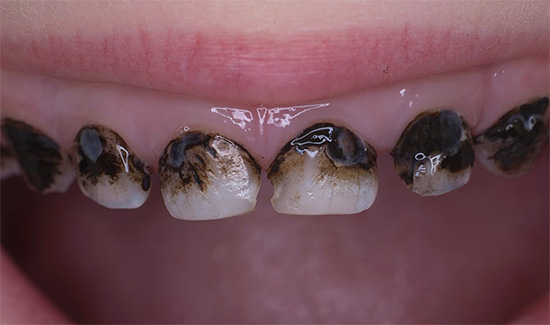
The disadvantages of this method are the need to constantly update the silvered layer and the unaesthetic appearance of the teeth (they look almost black). Actually, in order to replace the silvering method with more aesthetic and one-time procedures, modern methods of protection have been developed, for example, the aforementioned ICON system.
On a note
Many dentists have a negative attitude to the silvering technique, based on the frequent darkening of the teeth after it, as well as due to the questionable effectiveness of the procedure (especially when dentin is involved in the carious process). If the clinic has modern equipment, silver plating should be abandoned only because the fight against carious black teeth will, at best, lead to cured black and ugly teeth.This can cause psychological trauma to the child in the group of children who will laugh at him.
Here are some more photos of silvered teeth:
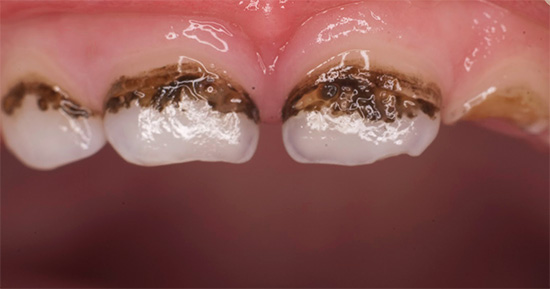
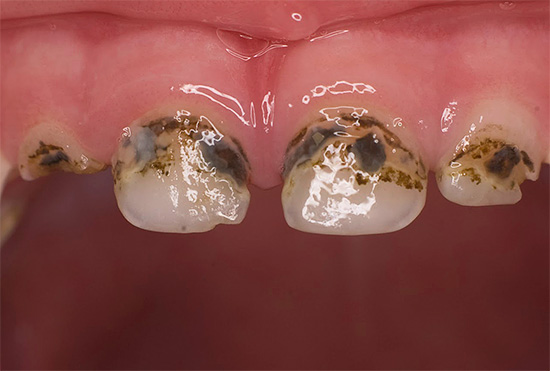
In the elite clinics, silvering of the teeth is not done today.
If the areas of tooth damaged by caries are darkened, this often indicates damage to the dentin and the need to remove the affected tissue with a drill. In this case, general anesthesia is sometimes used. Cleaned cavities after disinfection are filled with filling material.
For the manufacture of fillings on milk teeth, glass ionomer cements, compomers and light-cured composite materials are used. Most often, dentists prefer to treat deep bottle caries in children using glass ionomer cement. Although this is an older material, it provides a constant release of fluorine compounds into the demineralized tissues of the tooth surrounding the filling. In addition, cement fillings are prone to abrasion along with the milk teeth themselves, and therefore, even with long wear, they do not protrude beyond the edges of the teeth and do not affect the bite of the child.
From the practice of the dentist
Most dentists are of the opinion that the treatment of bottle caries in children under 2 years of age most often requires the use of general anesthesia (anesthesia), since the qualitative restoration of the function and effectiveness of the affected teeth, as well as their aesthetics, requires 2 or more hours. A conscious child will never allow to do such a big job, and breaking it up into separate techniques is an extra psychological trauma. However, even an effective method such as dental treatment under general anesthesia has contraindications, therefore it is necessary to determine with the doctor the possibility of its use in a particular child, permissible risks and complications. The level of equipment of the clinic and the professionalism of the doctors significantly affects the outcome of the upcoming treatment.
The colored fillings used today are made of compomers that emit fluoride in the tooth tissue, like glass ionomer cements, but are very stable and aesthetic, like light-cured composites. Their main charm lies just in the bright colors of the material, which carry children and make the whole procedure like a game.
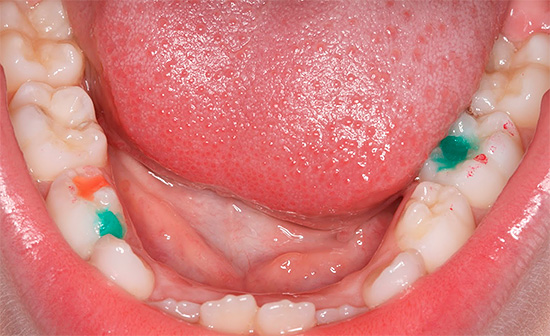
This is true for children over 4-5 years old who can compete with their peers and show off their colorful fillings. Thus, the treatment of bottle caries in them turns into entertainment, and the doctor gets a calm child in the chair.
On a note
The price of a color seal is not much higher than the cost of a simple one. This means that if the clinic calls one and a half to two prices for simple fillings for such childish joy, then this is an overstatement.
How to prevent the onset and development of the disease: prevention from the first months of life
Mer prevention of bottle caries in children several, and all of them are divided into two types: measures of local protection against caries and measures of systemic prevention.
The first are:
- Brushing your teeth is important for all babies who have at least one tooth. For the smallest children (up to a year), simple gauze tampons moistened with water, tea or chamomile broth, soft brushes worn on the finger of one of the parents, special napkins (Spiffies, Teeth Cleaners) are used for cleaning. With one and a half years old, a child can already be taught to use a children's toothbrush.
- The use of anti-caries gels for the treatment of teeth.
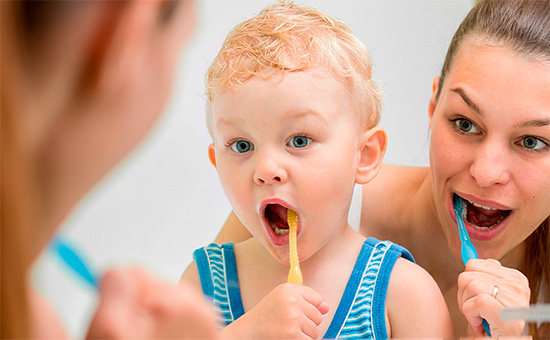
Systemic prevention consists of the following actions:
- Compliance with the diet, the rejection of night feedings and feedings after brushing your teeth.
- Correction of the diet, reducing the number of sweets, flour products in it, increasing the number of fresh fruits and vegetables, fish, dairy products, greens.
- Observance of basic hygiene measures: do not lick the spoon, which the child eats, or the pacifier that has fallen on the floor. Cariesogenic bacteria from the parents' mouth may not be familiar to the baby’s body.
From the practice of the dentist
Many dentists and pediatricians are of the opinion that sweet juices are detrimental to milk teeth, as they contain easily fermentable carbohydrates that quickly form plaque. If a child is already accustomed to juices, then it is easy to wean him off: the juice should be gradually diluted with boiled water until it turns into water, and it can be given to the baby even at night without the risk of bottle caries.
In general, the child should be weaned as soon as possible from the nipple and in no case be smeared with jam or syrup. A healthy child can calm down and fall asleep simply with the caress of parents.
And if the baby is naughty and crying for no apparent reason, this is a reason to show it to the doctor. Do not be afraid of doctors: no one recognizes a disease better than them at the stage when it is not difficult to cure it. And be healthy!
Interesting video: detail about bottle caries (expert says)
How to take care of the teeth of a child from birth

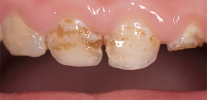
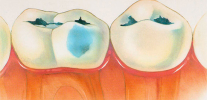
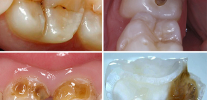
I live inBratsk Irkutsk region. Our doctors do not even know what bottle caries is, and they say that there is no such type of caries. She turned to Irkutsk - and I was delighted that they were familiar with this, agreed to cure. Now you have to go for 1000 kilometers, but the main thing is that the baby's teeth are healthy 🙂
Julia, please write the address of the clinic that agreed to treat your child’s teeth in Irkutsk. Urgently need.
I live in the city of Brest. Do we have doctors in Lode treat bottle caries only from the age of 14, and what, until that time, the child will walk with rotten teeth? And to his peers laughed at him. Tell me, where in the city of Brest can you cure such caries?
Friends went to Minsk. The child is 2 years old. Under anesthesia were treated.
What a bottle of caries at the age of 14, they are there, they already treat permanent teeth at this age!